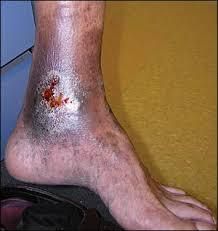Over the last few decades the treatment of chronic wounds (wounds that haven’t healed in 4 weeks) has become increasingly complicated and expensive. Thousands of specialized “Wound Care Centers” have cropped up across the country. The idea behind these is founded on the fact that getting these types of wounds to heal often requires physicians and nurses of different backgrounds and with special training. These centers are often made up of physicians such as podiatrists, general surgeons, orthopedic surgeons, vascular surgeons, plastic surgeons, infectious disease doctors, diabetic specialists, etc. The reason for that is that it is often the underlying medical issues such as diabetes, poor nutrition, the presence of infections, the use of drugs to treat diseases such as Lupus or Rheumatoid arthritis, that contribute to the poor healing of wounds. In addition, multiple products, surgical and nonsurgical techniques, and “advanced wound care therapies” are used when wounds just won’t heal.
Silicon Valley’s South Bay Vascular Center and Vein Institute doctors are recognized as the leading wound care doctors in the greater San Francisco Bay Area. Recognized as the one of the leading wound care doctors in the country, Dr. Kokinos serves as the medical director of both the Verity/O’Connor Wound Care Center in San Jose and the St Louise Hospital Wound Care Center in Morgan Hill, CA. Dr. Kokinos brings her cutting edge expertise in wound care to patients from all over California who come for treatment at these facilities.
One of the most “hyped” of these treatments is the use of Hyperbaric Oxygen. This is 100% oxygen (normal air is about 21%) that is pressurized in a special tank and breathed by the patient over a period of about 90-120 minutes. This is done daily for thirty to forty treatments. It has been shown that this increases oxygen delivery to the tissues around the wound, and thus increases healing. Originally used to treat “the bends” after a scuba diving accident, today, most “dives” in the hyperbaric chamber are done for wound healing. Many insurers pay for this IF
- The treatment is used to treat certain classes of wounds and
- The wound has failed to improve after four weeks of standard therapy.
It is critically important that those two conditions are met, as hyperbaric treatment is not only quite expensive, but does have some significant side effects associated with it.
BE ADVISED: Often times wound care centers will promote this type of advanced therapy before adequately evaluating/treating the patient for the underlying factors that can contribute to non-healing. This is particularly true for vascular causes and is why before beginning any hyperbaric oxygen treatments patients must be seen and evaluated by a Vascular Surgeon. Vascular Surgeons are uniquely trained and qualified to evaluate the state of a patient’s underlying circulatory issues and patients should only agree to this kind of therapy only after speaking with their vascular surgeon.
Previously, vascular therapies often entailed long, dangerous operations to open blocked arteries. However, now, most of these treatments are minimally invasive (done through a poke in the groin or foot) and are often done in the office. Almost all patients, no matter how old nor what other medical conditions they may have, are candidates for these safe procedures.
Hyperbaric oxygen is also used for wounds in areas that have been radiated or that are the result of diabetes. Again, it is critical to optimize all other factors before progressing to “diving” or hyperbaric treatments.
